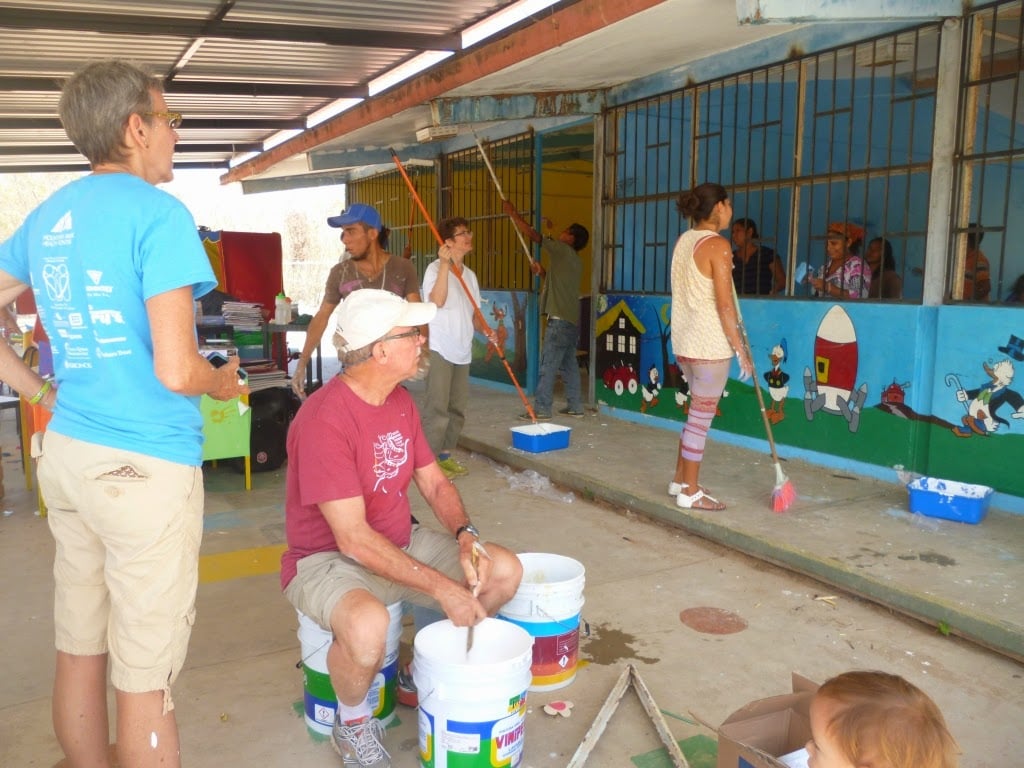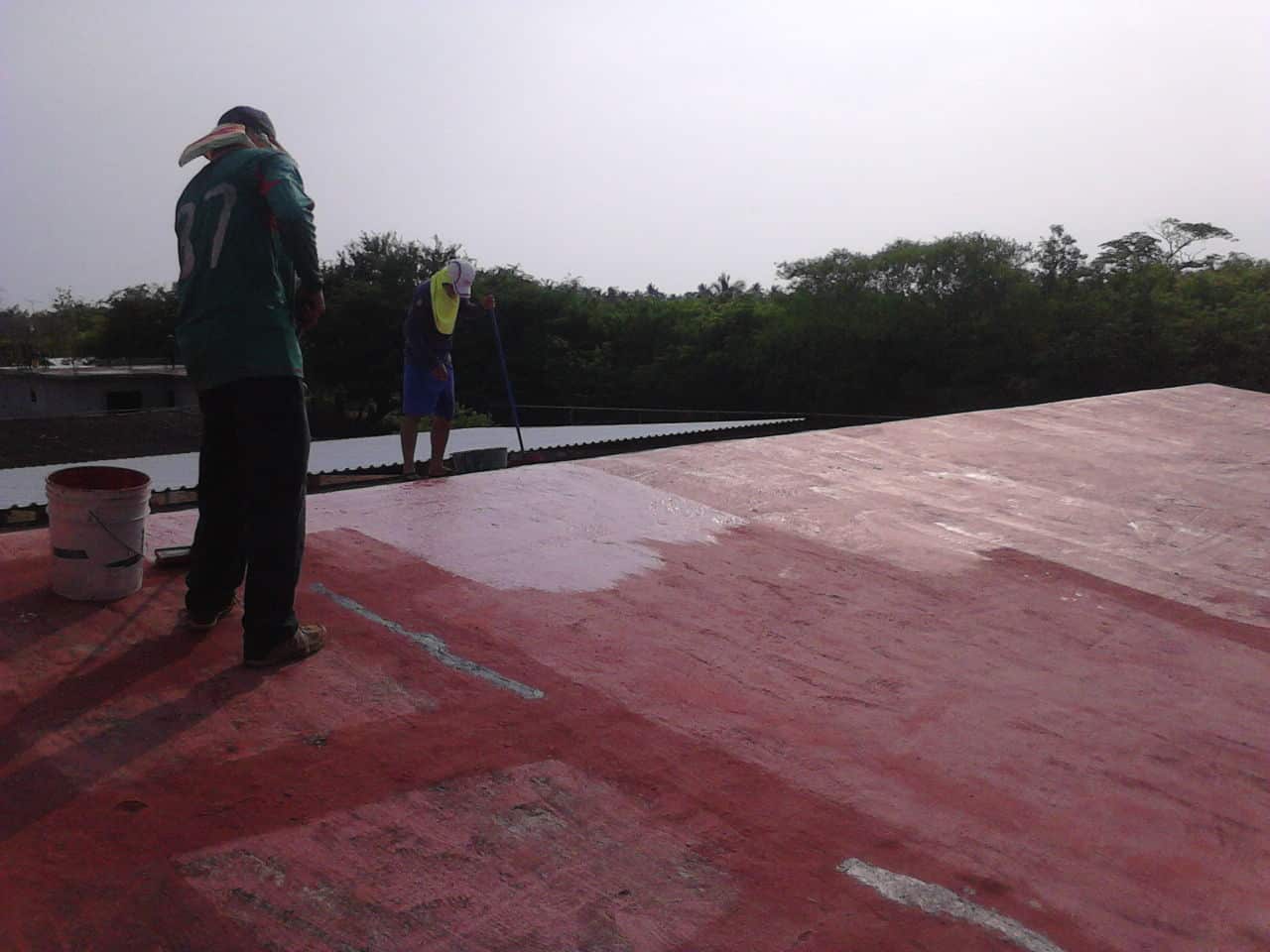 Following up on a story from March of 2014, when a group of guests and parents of the local kindergarten joined together to paint the school, one of the outcomes from that “painting party” was that the paint needed to be re-applied almost yearly. The reason why was that the roof was leaking and thus the paint was peeling almost annually. When this story was recounted back at Playa Viva by the painting party, other guests staying at Playa Viva took it upon themselves to donate the funds to pay for sealant for the leaky roof. These funds provided by Playa Viva guests along with a funds raised by the kindergarten parents was sufficient to pay for the sealant and even give a small fee to the volunteers who applied the sealant. Here is one of a few photos forwarded by one of the kindergarten teachers to show that the work was finally done just in advance of the coming rainy season. Thank you to our guests for the original painting party as well as for those guests providing additional funds to seal the roof. This extra layer of protection will hopefully allow the paint to last longer and next year’s “painting party” will have to take its talents to a new school or community center.
Following up on a story from March of 2014, when a group of guests and parents of the local kindergarten joined together to paint the school, one of the outcomes from that “painting party” was that the paint needed to be re-applied almost yearly. The reason why was that the roof was leaking and thus the paint was peeling almost annually. When this story was recounted back at Playa Viva by the painting party, other guests staying at Playa Viva took it upon themselves to donate the funds to pay for sealant for the leaky roof. These funds provided by Playa Viva guests along with a funds raised by the kindergarten parents was sufficient to pay for the sealant and even give a small fee to the volunteers who applied the sealant. Here is one of a few photos forwarded by one of the kindergarten teachers to show that the work was finally done just in advance of the coming rainy season. Thank you to our guests for the original painting party as well as for those guests providing additional funds to seal the roof. This extra layer of protection will hopefully allow the paint to last longer and next year’s “painting party” will have to take its talents to a new school or community center.
Halcyon Days with Master Mixologist Don Johnny
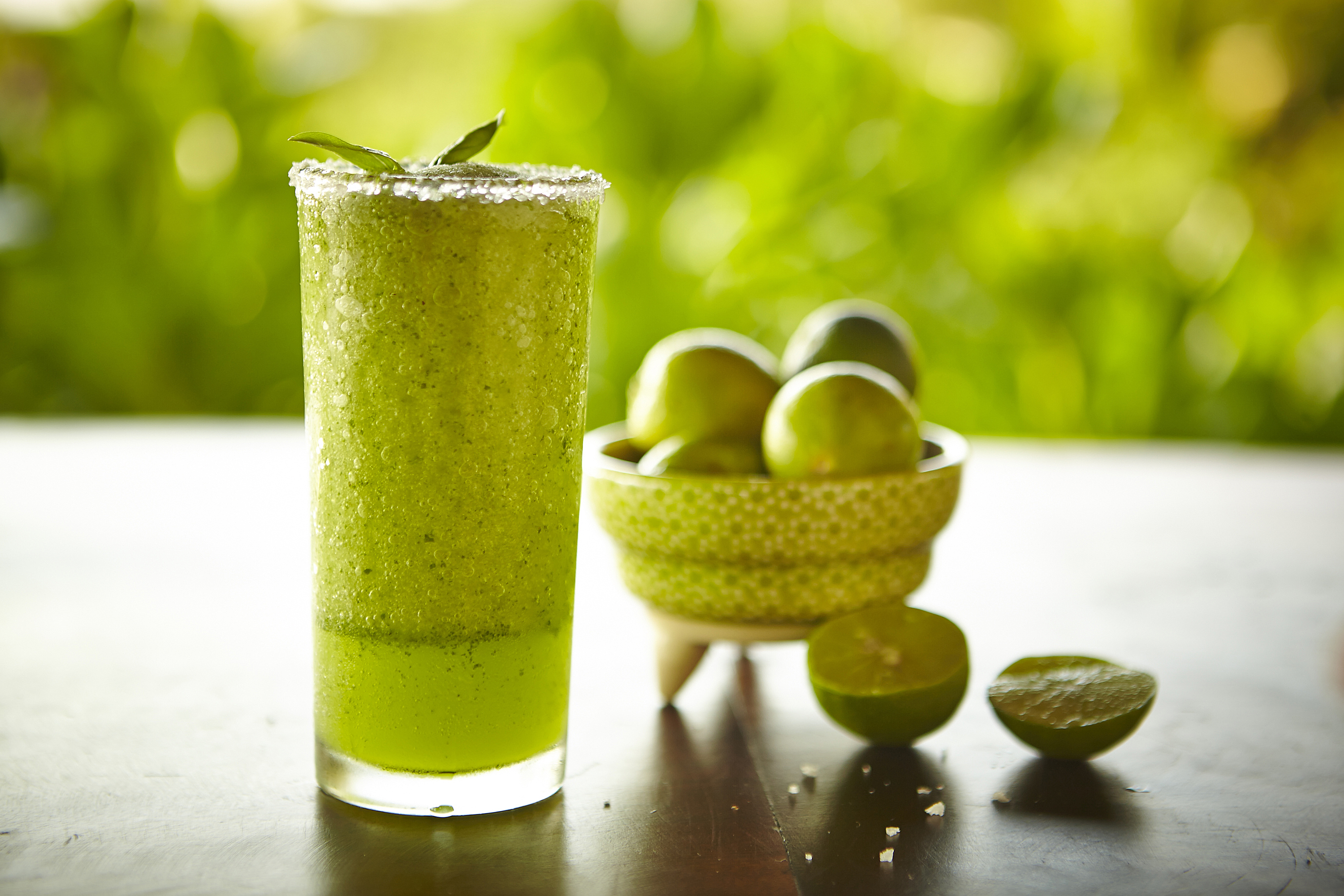
Guest Blog by guest Jim Neeley with photographs by Tom Seawell
We are just back
from spending five
wonderful days
celebrating
a 25th anniversary
at Playa Viva.
A group of 14 friends
and family joined us
for the celebration.
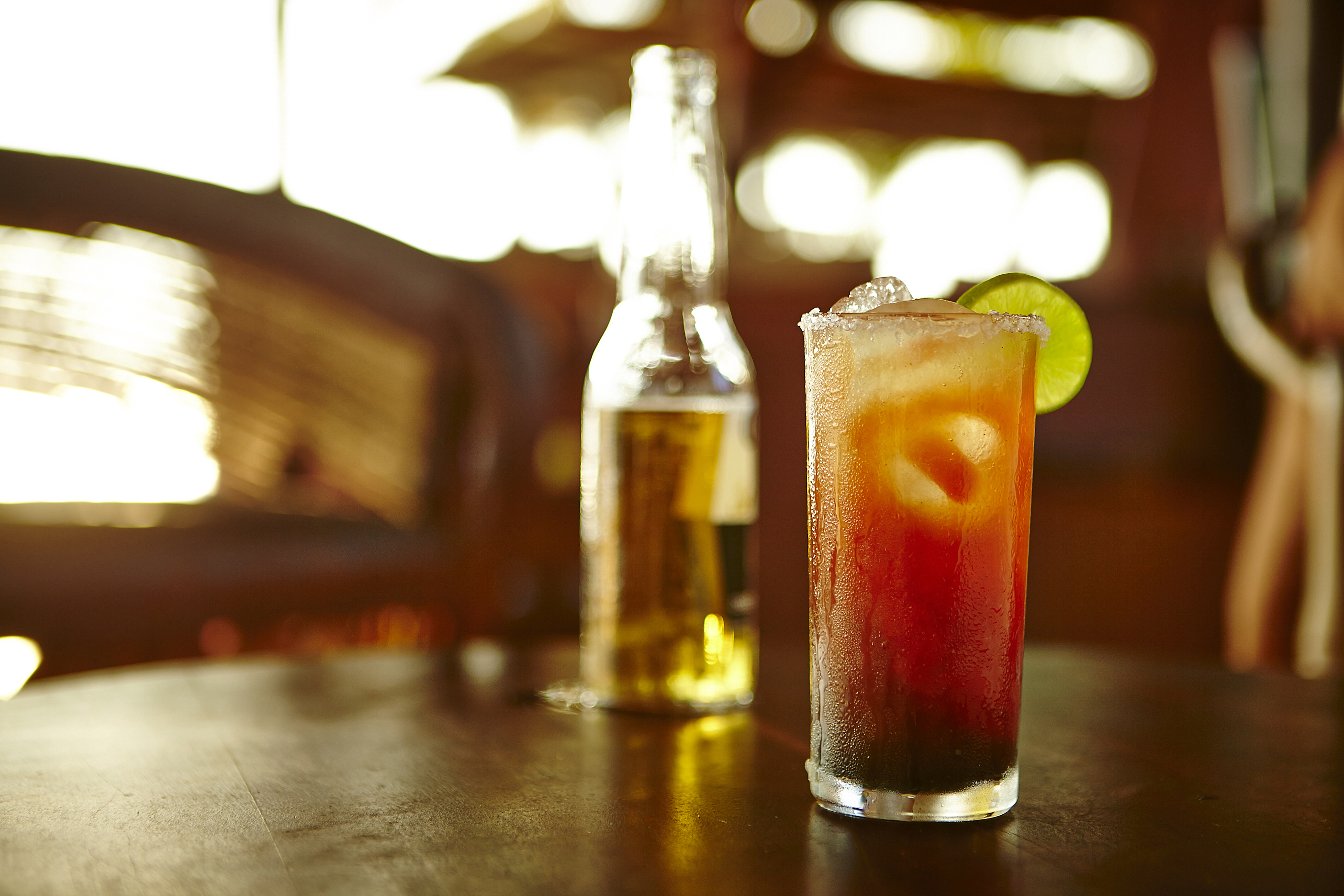
Lazy days were filled
with morning yoga,
quiet conversation,
napping in hammocks,
sharing great meals,
riding the gentle surf
and being pampered
by the gracious team
that is Playa Viva.
Guests were invited
to participate in meal
preparation in the open
kitchen.
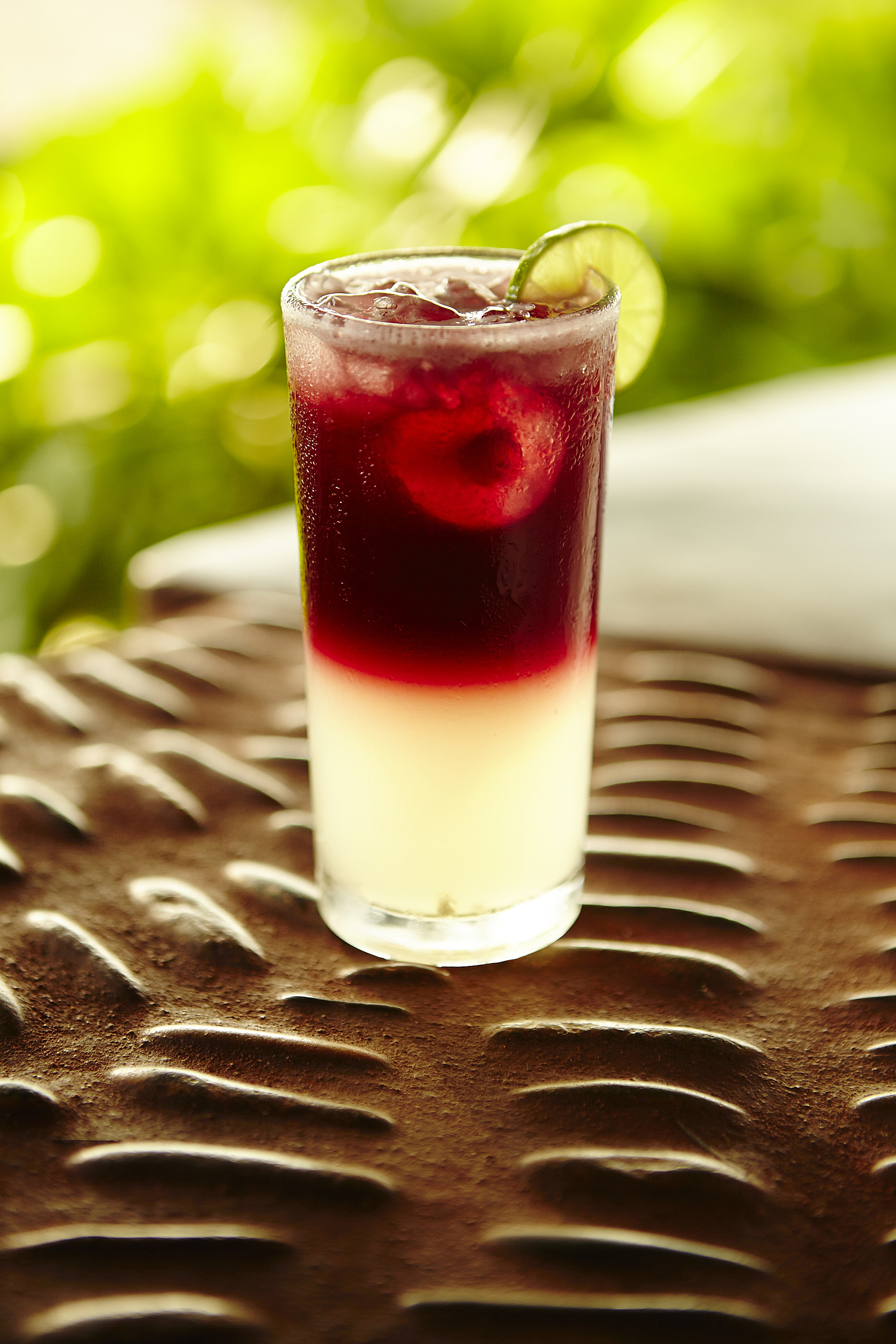
And to learn a few
of the secrets from
the irrepressible,
never at a loss for words,
activities organizer extraordinaire
and Master Mixologist
Don Johnny.
More than a few of his
trademark cocktails
were poured for our guests
over these five halcyon days.
Actually a lot more
than a few drinks.
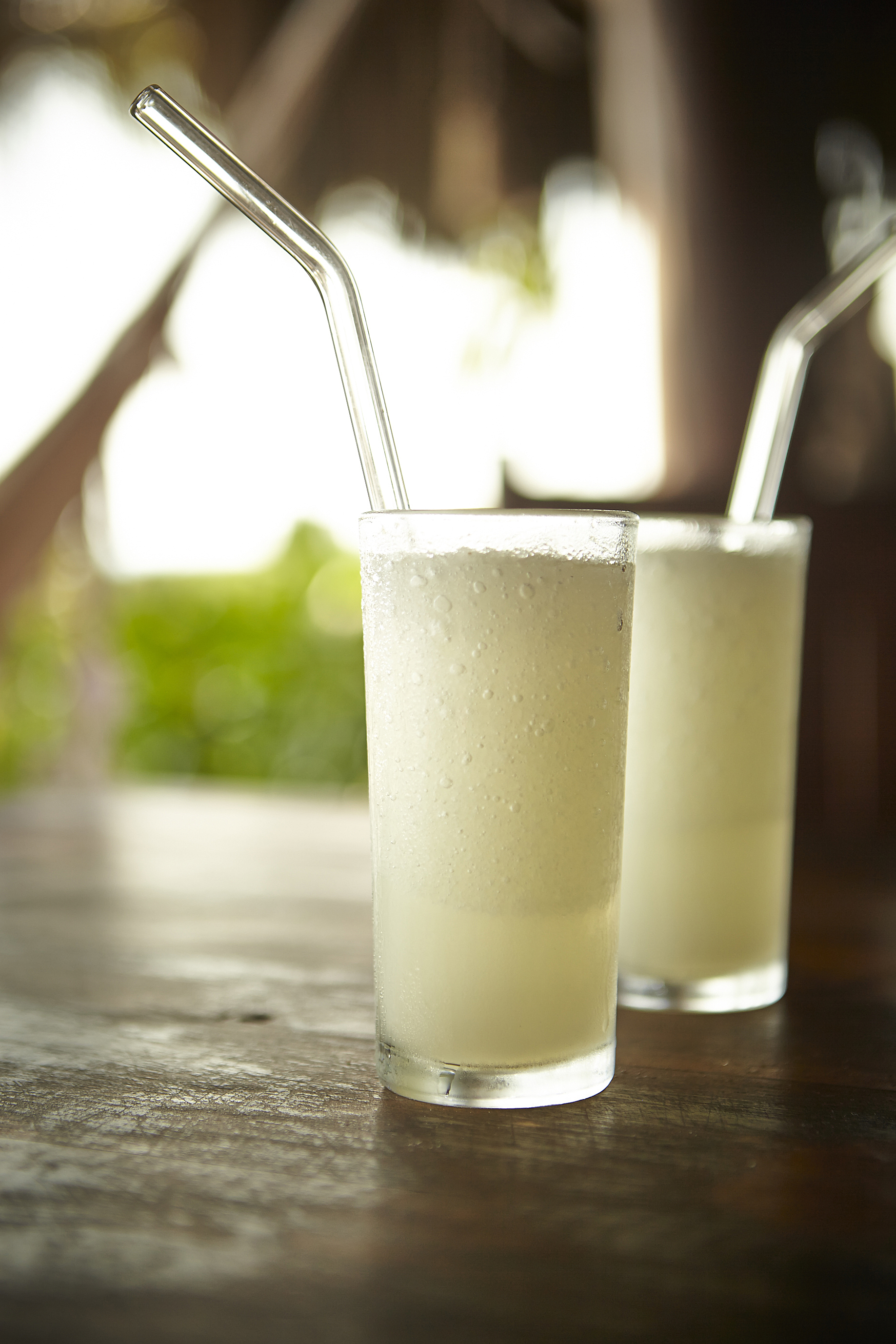
Our very special friend and
professional photographer,
Tom Seawell with an
impromptu stylist assist from
his wife Laura created
these beautiful images
of a few of Johnny’s concoctions.
Cheers!
How Lucky to Participate in Protecting a Life So Rare
Guest blog, submitted by Debbie Greenberg
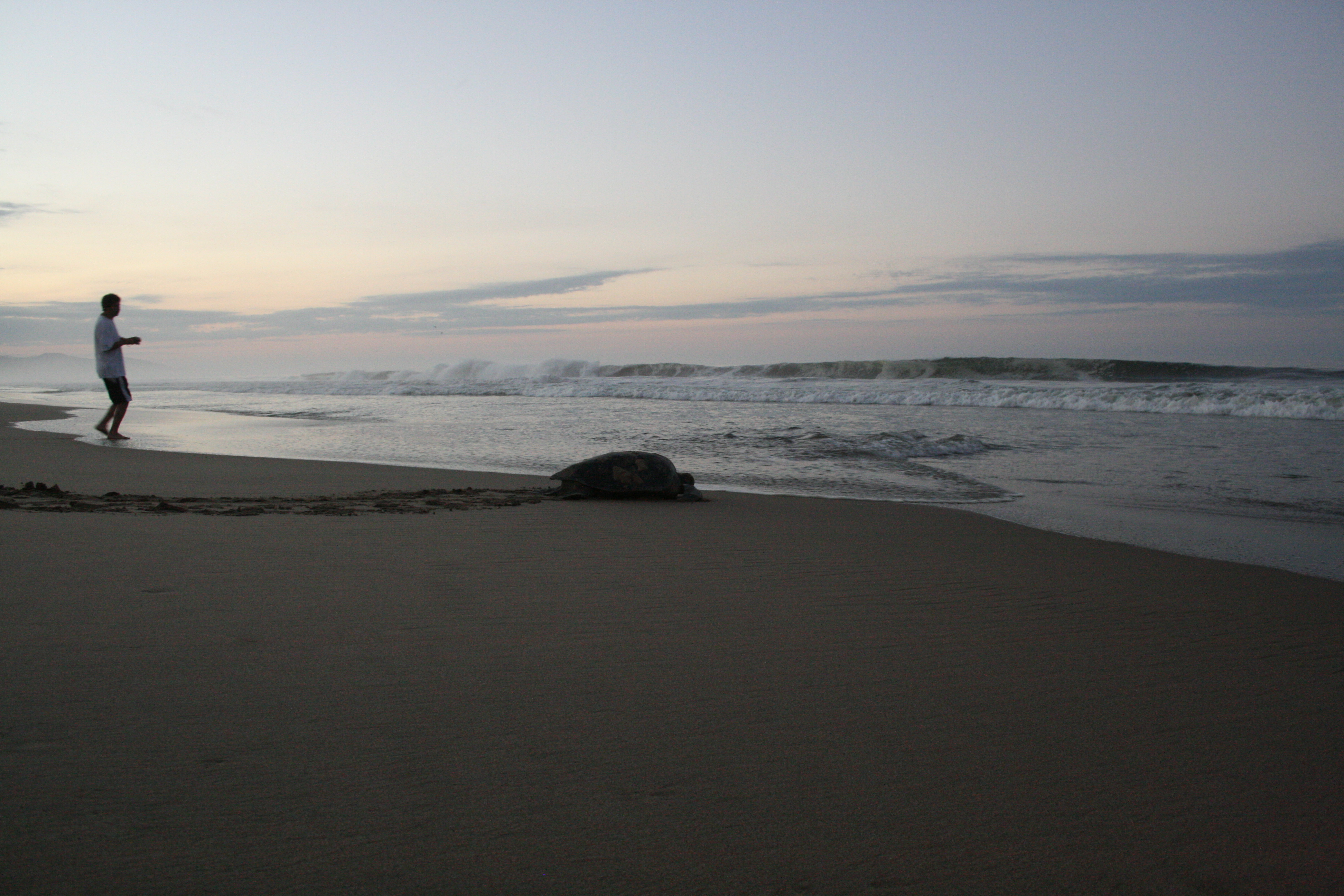
One week ago I was fortunate enough to accompany members of the La Tortuga Viva turtle sanctuary on one of their nightly patrols of the beach near Playa Viva and beyond. They search for sea turtle nests in order to protect the eggs from poachers and predators by moving them to their nursery for safekeeping until they hatch and are released.
It was very interesting to see first-hand the work done by these local volunteers and better understand the effort they make every night and early morning (one patrol is from 10 p.m. to about midnight and another begins at 4 a.m.) The stars over the ocean were incredible as we bounced along on the group’s one all-terrain vehicle. Elias, head of Tortuga Viva and my guide for the night, explained how to look for turtle tracks and nests. We were unlucky, though: we found two nests, but unfortunately human poachers had beat us to them and the eggs were gone. We also saw 3 dead turtles at different points along the beach, most likely drowned at sea by the nets of fishing trawlers.
All was not lost, we were tremendously lucky because when we got back to the nursery enclosure at midnight a nest was hatching, and I actually got to see the baby turtles making their way up through the sand! Elias gently began moving sand aside and carefully collected handfuls of baby Olive Ridley turtles for release back to the ocean.
One week later, when we WWOOF volunteers arrived at Playa Viva for work at 6:30 a.m. we were told by the Playa Viva team that a turtle was on the beach right in front of the hotel. We ran pell-mell down to the sand, scrambling for our cameras, fearful of missing the sight; lucky for us the turtle wasn’t moving too fast, so we were able to watch as she lumbered back into the sea. It was a very big turtle (about 3-4 feet long) and it turns out we were really lucky because it was extremely rare Black turtle, called “Prieta” by the locals (chelonia agassizii).
The turtle sanctuary volunteers were on hand, waiting for her to go back to sea before protecting her eggs by securing them from predators in the sanctuary. It was so exciting to see the tracks she had made coming up the beach, the two false nests she had made (apparently a natural defense mechanism against predators) and her tracks going down. The volunteers who were there gently probed the sand with a long stick, trying to find the true nest, but were worried they might damage the eggs. One went back to town to fetch a couple of more veteran Tortuga Viva members while the other stayed here to mark the spot and guard the nest against possible interference. He explained that although they had been working on the patrol for a year, they had never found a Prieta nest before. Once senior patrol members Elias and Hector arrived, they knew right where to look, and began to dig. Hector is tall and has long arms, but he dug down until he was leaning almost completely into the hole before finding the eggs. He began to gently bring them up, two or three at a time; they were round and about the size of large golf balls. 81 eggs in all!
By this time they had an audience of all the WWOOF volunteers, a Playa Viva staff member who had brought down a shovel to help if necessary, and several Playa Viva guests. The eggs were placed in a couple of bags and taken to the turtle sanctuary, and we followed them watch the rest of the process of securing the eggs for incubation. Once the eggs were safely buried in their new, man-made nest 65 cm deep, we were given a ride back to Playa Viva.
The Black turtle is highly endangered; lucky for her to have concerned volunteers on hand to safeguard her eggs, and what luck for us to have witnessed a species so rare to be almost extinct.
A Little Bit Helps Make a HUGE Difference in Small Communities
This blog post submitted by Debbie Greenberg – Volunteer at Playa Viva
A day at the kindergarten (March 13, 2014).
The parents at the local kindergarten in Juluchuca, Mexico have been working to renew the facilities, seeking funds from different sources to re-build the gate and the fence, paint the classroom and fix the leaking roof.
 A few weeks ago, the kindergarten parents mentioned their need for paint and rollers to Playa Viva’s General Manager, Julia Garcia. Julia mentioned the need to Playa Viva guests Charles and Linda who had asked Julia how they could donate to and participate in a community project while on vacation – voluntourism. Julia told Linda and Charles about the kindergarten and both generously agreed to buy the paint and equipment for the project, as well as offered to help paint.
A few weeks ago, the kindergarten parents mentioned their need for paint and rollers to Playa Viva’s General Manager, Julia Garcia. Julia mentioned the need to Playa Viva guests Charles and Linda who had asked Julia how they could donate to and participate in a community project while on vacation – voluntourism. Julia told Linda and Charles about the kindergarten and both generously agreed to buy the paint and equipment for the project, as well as offered to help paint.
On Thursday, March 13, 2014, a group from Playa Viva including Charles, Linda, Fernando and I (two WWOOF volunteers at Playa Viva) plus Miguel (the newest team member at Playa Viva) all went to the kindergarten in Juluchuca to paint! When we arrived a lot of the kindergarten parents were already scraping rough patches of old paint off the walls and completing other pre-painting preparations. Everyone pitched in wherever they could, or with whatever tool was at hand—if you found a free broom, you swept walls or window sills!
The “kinder” (“keen-dare”), as it’s called here, has one classroom for 3-year-olds and another that is divided between the 4- and 5-year-olds. The concrete walls separating the classrooms and administrative office go up to the roof, whereas the outer walls are solid concrete to about 4 ft. high —in other words, they are open air (see photos). There is a large roofed patio (mostly roofed—as the kinder is trying to raise money to complete the roofing for the patio) and a shaded play area with playground equipment. This particular Thursday the children were off school so it was a perfect day for the painting project to be completed.
After a bit, the work hit its stride and began to advance quickly. Unfortunately, we didn’t have enough time to sand down all the old paint, so there were patches where the wall or ceiling would peel (or crumble!) when you ran your roller over it, but little by little the ceilings became freshly white and the walls became sky blue. Teachers, parents, Playa Viva guests, Playa Viva staff and
volunteers were all working together – diverse communities coming together to make one.
At about 12:30 some of the women told us it was time to come eat—they had brought us plates of chicken with mole colorado and rice, as a way of thanking us for our help. During lunch we chatted about the school with a couple of the moms of children and with one of the teachers. They explained how difficult it is for them to get funds needed to repair the school due to the slow Mexican government bureaucracy. They commented about how unbelievably fast they had been able to obtain assistance via Playa Viva and guests Charles and Linda —they had mentioned the project to Julia, and in just a short time they had paint, rollers, and even some more hands to help with the project execution.
When we asked how long it had been since the rooms had been painted, we got a surprising reply: it had only been about a year! One of the teachers then explained that every year, during the rainy season (June-September) the classrooms leak, and the paint gets ruined. They had applied for government funding to have the roof waterproofed, and were informed that funding was on its way…however, the latest news was that only a portion of the requested funds would probably arrive and not until July – just as the rainy season starts! That would clearly be too little too late to save the nice new paint job.
The teacher further explained that they had been told they would receive $3,000 Mexican pesos (about $250 U.S. dollars) for the project. Based on this level of funding the waterproofing would not be sufficient. They would have to adjust their project so the initial funds approved would be used to cover the highest point of the roof with a 5-year waterproofing product, with rest of the roof only getting a 3-year waterproofing.
After the lunch, we all went back to painting (more detail work now) and helping them begin to move the classroom furnishings back into place. At least 20 parents were on hand, along with the teachers and principal, who thanked us again and gave us a round of applause for our help. We applauded their effort and determination in return.
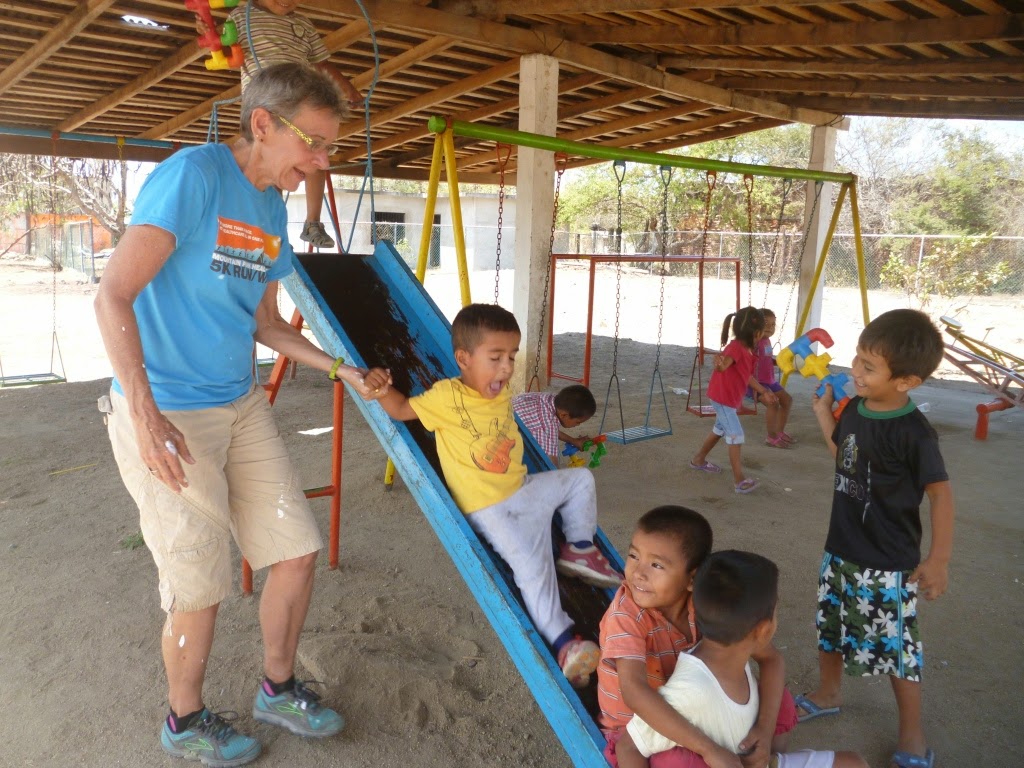
When we got back to Playa Viva, the other guests asked us about our morning and we told them all about it, including the conversation we’d had with the teacher over lunch at the kindergarten regarding the waterproofing of the roof. Later that evening, Playa Viva guests Sarah and Jim spoke with Julia about their wish to graciously donate the funds necessary to waterproof the entire roof so that it can be completed before the rainy season starts. I am quite touched by Sarah and Jim’s generosity. Julia will be checking to ensure that the waterproofing project is appropriately budgeted and the funds donated are efficiently used. Thank you all for giving to the local kinder.
NOTE from Playa Viva Owners: The painting of the kinder is a perfect example of Playa Viva’s core values of Creating Meaningful Community and Transformative Experiences. From a Social Impact perspective, we see our role as providing a platform for voluntourism and opening doors between guests and donors who in turn provide resources for specific community identified needs. It is important to us that the community self-identify needs. Furthermore, that the community beneficiaries donate their time (labor) as well as their own form of giving (sharing of food) with the donors and volunteers who came from outside. Finally, we loved hearing about the regenerative nature of voluntourism and charity that spread from Linda and Charles (painting) to Sarah and Jim (waterproofing). The result, we hope, is a better educational environment for children, a stronger community and an true cross-cultural exchange. If you are interested in donating to the kinder roof waterproofing project or to the Playa Viva Regenerative Trust to the local community – please click on this link to donate via our fiscal sponsor – the Ocean Foundation via the Friends of La Tortuga Viva fund. Thank you all.
Journey into a Community – WWOOFer/Nurse/Traveler/Organizer
This blog post contributed by Malene Jakobsen.
The ocean, nature, wildlife, mouthwatering food, friendship, insight in the Juluchucan way of life and a sense of being genuinely welcome and part of Playa Viva and the local community. These are just a few of the great experiences that I will take home with me after having spent a little over a month volunteering in the local health clinic in the village of Juluchuca. A project made possible through Playa Viva and their involvement with volunteers via the WWOOFing network.
My work as a volunteer in the health clinic has consisted of wound cleansing, injections, measuring blood pressure, blood sugar etc, and helping sort out the chaotic pharmacy. I’ve also had the privilege of carrying out a Pap smear and taking part in several educational meetings with the local women and their children. All of which have given me a unique opportunity of achieving insight in the life conditions of the inhabitants in the village, and of catching a glimpse of what challenges they are dealing with such as poverty, early teenage pregnancies and unemployment.
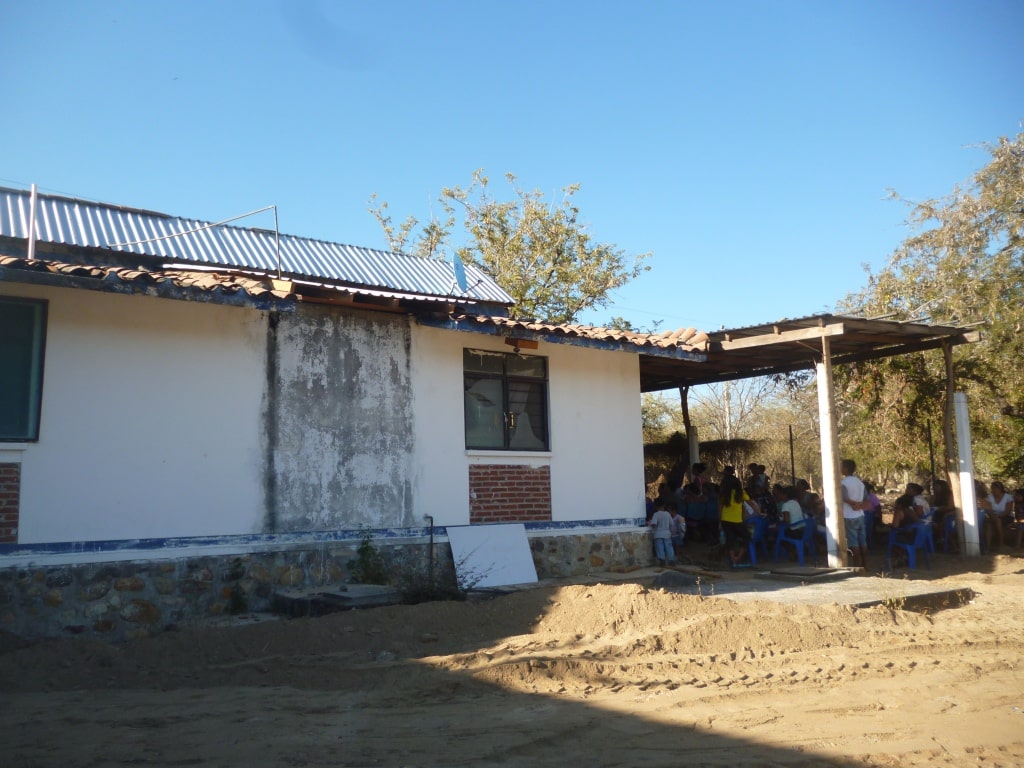 Another function of mine in the clinic has been being the person in charge of “the leaky roof project”. Together with the help of the kind guests and donors at Playa Viva we have managed to gather enough money for the materials for the construction of a new roof in the clinic, since the existing one was very leaky and would have resulted in serious problems with the coming rainy season during spring and summer.
Another function of mine in the clinic has been being the person in charge of “the leaky roof project”. Together with the help of the kind guests and donors at Playa Viva we have managed to gather enough money for the materials for the construction of a new roof in the clinic, since the existing one was very leaky and would have resulted in serious problems with the coming rainy season during spring and summer.
The local board of health in the municipality of Petatlán is considering constructing a new and bigger health clinic in Juluchuca, but that is not definitely decided, and might take a couple of years before that becomes a reality.
The doctor and I have held several meetings with the most efficient decision makers in the village – the women, and we have together decided, that the best use of the money would be to have an aluminium construction build above the existing roof.
It has all along the process been crucial that the locals part take in the decisions and the work, and a representation of the locals has therefore agreed that every household in Juluchuca and surrounding villages contribute with 20 pesos each for paying for the manual labour needed, provided that the donations would pay for the materials.
The end result with the aluminium roofing has turned out to be a cheaper solution than first estimated and so a fund has been created for further possible improvements in the clinic, such as a new examination bed, an oxygen container and a manual resuscitator. All of which will be able to be used in a new clinic as well. This might be a little project for a future volunteer.
During my two months stay in Mexico I have all along felt more than welcome, both at Playa Viva, in the clinic, in the village and all along the pacific coast. I have been able to contribute in a small scale to the improvement of the facilities in local community and I have experienced a kindness, an interest and an openness towards me that has felt genuine and has been moving. And these have been some of the most important factors of making this work holiday/vacation one of my best journeys ever.
Turning the Tables on The Team
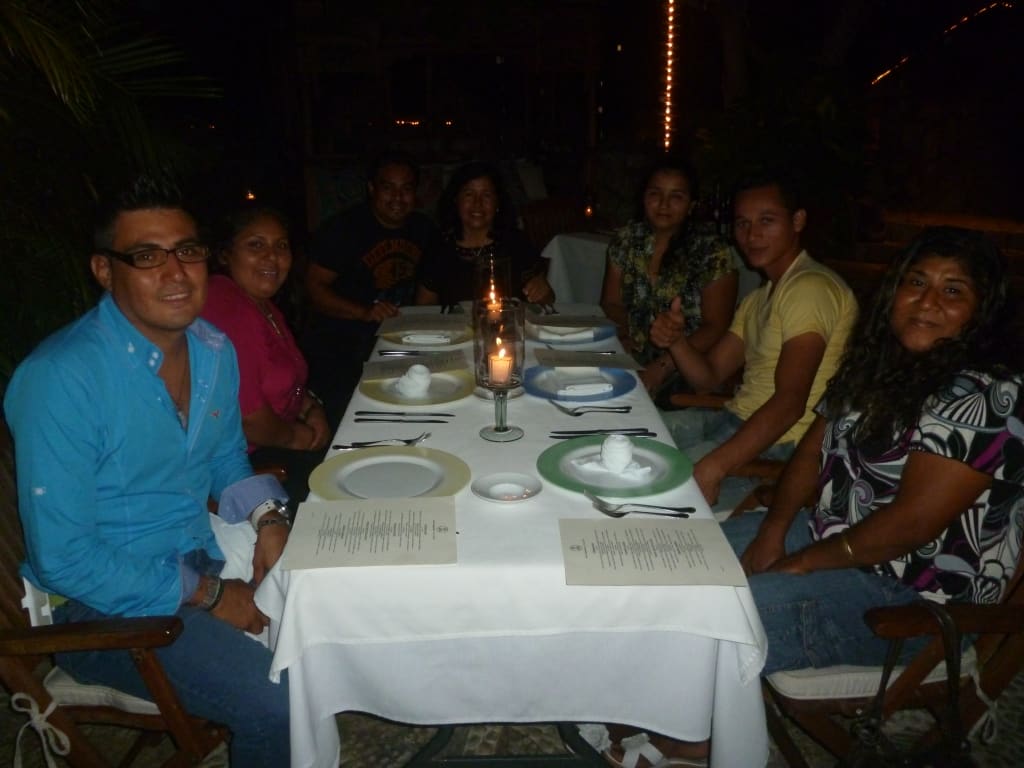 Right after the holiday rush, we had a little break and Julia took advantage of this lull to take the entire service team out to a “fancy” dinner. This was both a “thank you” as well as a training moment as many of the team who are supposed to be providing a luxury level service for our guests have never experienced that level of luxury themselves. The perfect choice for this dinner was at one of our favorite local little boutique hotels in Zihuatanejo – Amuleto. NOTE: We hope to be able to visit with all the other great boutique hotels in Zihuatanejo to share your great service and offerings with our team…one at a time.
Right after the holiday rush, we had a little break and Julia took advantage of this lull to take the entire service team out to a “fancy” dinner. This was both a “thank you” as well as a training moment as many of the team who are supposed to be providing a luxury level service for our guests have never experienced that level of luxury themselves. The perfect choice for this dinner was at one of our favorite local little boutique hotels in Zihuatanejo – Amuleto. NOTE: We hope to be able to visit with all the other great boutique hotels in Zihuatanejo to share your great service and offerings with our team…one at a time.
Everyone had a great time, maybe too good a time…ask Julia to tell you the stories of the late night in Zihuatanejo.
The only downside of this “perk” was that all the other team members (the permaculture and security team) wanted to know why they weren’t invited as well. In fairness, they all go out as a group more often, just not to such “luxurious” locations.
To our guests, we thought you would enjoy seeing the tables being turned and seeing Abraham, Olga, Elisea, Miguel, Inez, Johnny and Julia being served rather than doing the serving.
What you can measure you can manage
When we first undertook the GIIRS (Global Impact Investing Rating System) assessment in 2013, we realized that while we thought we were doing “all the right things” we could do a better job of tracking our progress to see if we were actually getting it right. Thus obtaining key metrics and measuring our performance against those metrics became our goal for Season 4.
We decided to start by tracking a few easy, or at least we thought they should be easy to measure, key items. They were our usage of: Water, Electricity and Natural Gas, plus keeping track of the Waste we created (Compost and Recycling), and finally tracking the school supplies donated by guests under our Pack for A Purpose partnership.
As a prelude to sharing the results, I must confess that our tracking systems are not extremely scientific and many of the measures are, well, estimates, especially when it comes to water consumption. In the case of water consumption, the ideal scenario would be to have a water meter on our supply tanks and have 100% of water flow through those tanks. In reality, we have two 10,000 liter tanks (for hotel use), one 5,000 liter tank (mostly used for agriculture irrigation) and a 2,500 tank (usually for reserves). We sometimes have a water truck come and fill the pool with river water (which is generally not included in the water measurements). Finally, we measure our water usage with help from our maintenance and security team: one of them usually climbs the hill to where the water tanks are located and tries to estimate of how much water it will take to fill the tank, and using this figure can estimate how much water we’ve used in the last 24 hours. It’s not the most precise process, but, in the aggregate, is probably not that far off from our actual usage.
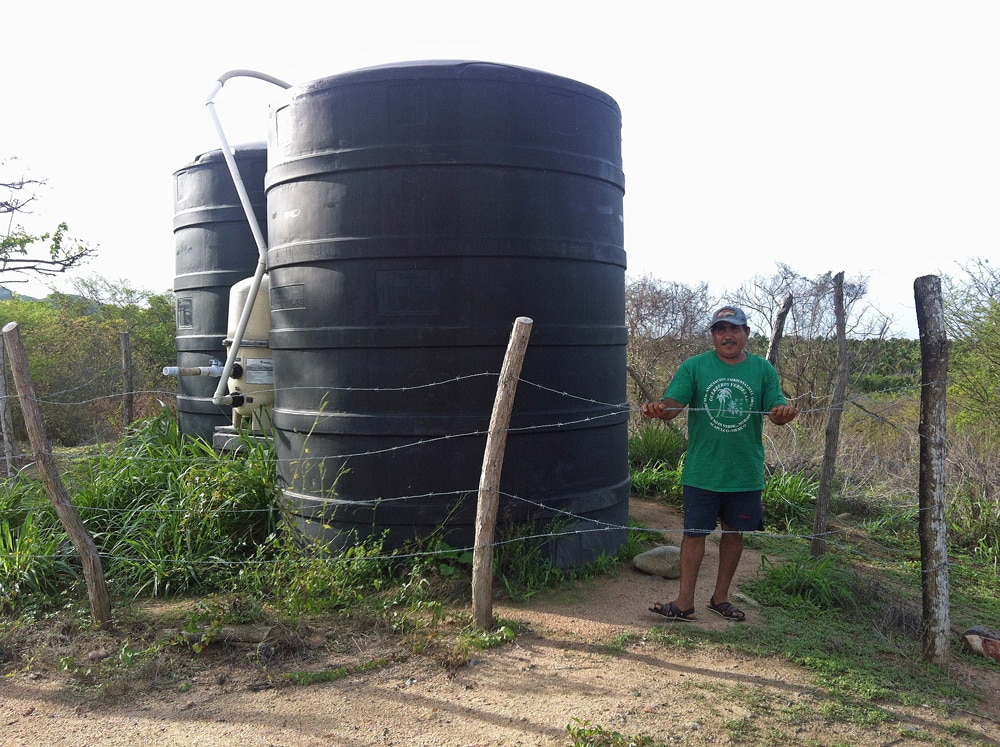 Members of the security team also take readings off our solar system to estimate our energy consumption during the last 24 hour period. But they often don’t get readings at the same time of day and sometimes the readings that they record are so off from one day to the next (even when the number of guests stays the same) as to indicate that the person doing the “reading” might be mistaken in the data they are transcribing – either recording the energy level in the batteries or the total energy produced, rather than the total energy consumed. For example, we might see readings of 54-58, usually the level associated with the batteries, while the readings the day before and day after with the same number of guests might be 24 or 29.5. We will work on increasing data accuracy, which means more staff training as well as adding better metering equipment, like a simple water meter on the water tanks to provide daily and cumulative water use.
Members of the security team also take readings off our solar system to estimate our energy consumption during the last 24 hour period. But they often don’t get readings at the same time of day and sometimes the readings that they record are so off from one day to the next (even when the number of guests stays the same) as to indicate that the person doing the “reading” might be mistaken in the data they are transcribing – either recording the energy level in the batteries or the total energy produced, rather than the total energy consumed. For example, we might see readings of 54-58, usually the level associated with the batteries, while the readings the day before and day after with the same number of guests might be 24 or 29.5. We will work on increasing data accuracy, which means more staff training as well as adding better metering equipment, like a simple water meter on the water tanks to provide daily and cumulative water use.
Playa Viva – Resource Utilization Averages – Season 4
Regardless of how accurate the numbers may be, our results are still interesting. The following are the results obtained for Season 4 (Oct 2012 to July 2013) – the quantities are all listed Per Guest:
- Water: 470.94 liters
- Solar: 1.42 kWh
- Gas: 43.88 liters
- Compost: 2.19 kg
- Recyclables: 0.14 kg
Putting the Numbers in Context
So you’ve seen our results, but how do these numbers compare to “normal” use? A quick search found the following comparable figures.
Agua – For the question of, “What is the water usage per person at a hotel?”, my research resulted in figures as low as 250 liters per person to 1800 for a luxury hotel guest. Interesting numbers from a sustainable tourism site state:
“For example, the average water consumption in Antalya City (Turkey) is 250 litres per person a day, while the average water consumption in the tourist areas of Antalya exceeds 600 litres. In Mallorca (Spain), water consumption in rural areas is 140 litres per person a day, in urban areas 250 litres, while the average tourist consumption is 440 litres, or even 880 litres in case of a luxury establishment (EEA, 2001).”
Given the numbers above, we seem to be slightly higher than average tourist consumption for Mallorca, Spain (470 at PV vs. 440 in Mallorca) and definitely lower than a typical “luxury establishment.” Working with staff and guests, I would like us to target consumption of 440 or less per guest for Season 5 (Oct 2013-July 2014).
Electricity – So how does our electricity usage compare? Given that we are 100% off-grid solar and employ many strategies for limiting electricity use, including the use of two gas refrigerators, I would expect our usage to be lower than the average hotel or even home. The best numbers I could find related to energy use boiled down to usage for the average American of about 8-13kWh per day, and Americans are by far, the largest users of electricity in the world. Even given the potential of inflated numbers due to inaccurate readings by our team, the average electrical usage per person, per day at Playa Viva was only 1.42kWh, about 10-20% of the average per person in the US.
Other Metrics and Notes
I have yet to do similar comparisons of compost and recyclables or even natural gas usage. If any of our readers can suggest good data sources on these, we would appreciate your recommendations.
In January 2013, we basically doubled our solar array, thus doubling our ability to produce solar electricity. At the same time, our gas refrigerators have reached, for the lack of a better term, ‘full depreciation.’ Thus, our use of natural gas should go down significantly as we limit its use to cooking and the backup generator. Electricity use will go up as we replace our gas refrigerators with electric refrigerators. The gas backup generator, I’m happy to say until the writing of this blog, has only turned on for its weekly automatic test and has not had to be used for a full system “backup.” This may change with the addition of new electric refrigeration. In summary, at least now we have some basic measurements and can compare usage over time. We now can measure and hopefully better manage our resource utilization and reduce our overall environmental impact.
If you are interested in more information about these key metrics or recommend that we keep other measurements, please let us know what interests you.
Urgent Care – Items Needed for Juluchuca Health Clinic
Teaming up with Pack for a Purpose, on-site volunteer and nurse from Denmark, Malene Jakobsen, has developed short list of critical items needed for the local health clinic. This just a list of supplies. We will also be raising funds to do some needed renovations in the coming weeks.
To see the list on Pack for a Purpose site – haga clic aquí – and scroll down to “Project 2” or see list below:
Medical:
Blood pressure cuff – Digital, Examination gloves, Manual resuscitator, both child and adult size, Pen-torches / flashlights, Scissors, Spacers for asthmatic patients, Tweezers and Urine dipsticks
We will be updating this list from time to time. Regardless of whether you are a health professional, your assistance in obtaining any of the items on this list and donating them to the local health clinic would be most appreciated. Keep in mind the limitations allowed by customs, any items that have an aggregate value of over $300 are subject to import duties upon your arrival into Mexico (above and beyond your personal items packed). If you have any questions about what to bring or how to declare with customs, please feel free to email us at info @ PlayaViva.com.
Thank you for your support.
Leaky Roof and Shattered Windows: Juluchuca Health Clinic In Need
Contribution by Malene Jakobsen, WWOOFer Volunteer and Nurse from Denmark.
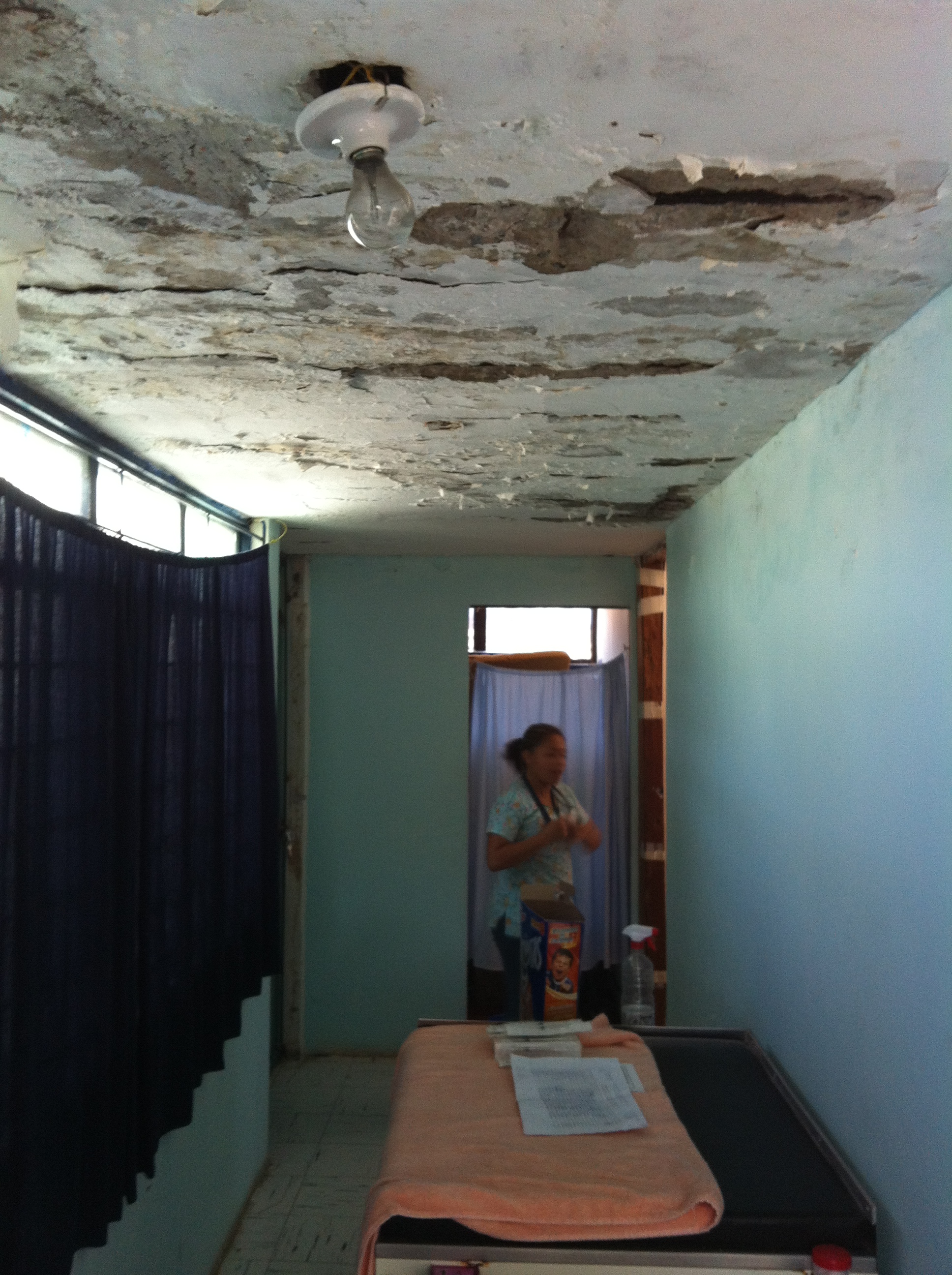 Coming to Playa Viva feels like discovering a hidden treasure. Located right on the beach of the crystalline waters of the Pacific Ocean, Playa Viva seems to blend in perfectly with the natural exotic surroundings. One easily gets carried away here just contemplating how beautiful nature is and how wonderful life is in the midst of it all.
Coming to Playa Viva feels like discovering a hidden treasure. Located right on the beach of the crystalline waters of the Pacific Ocean, Playa Viva seems to blend in perfectly with the natural exotic surroundings. One easily gets carried away here just contemplating how beautiful nature is and how wonderful life is in the midst of it all.
My objective in coming here is to experience this extraordinary place and also to do some voluntary work at Playa Viva or in the nearby community. Being a nurse from Denmark the possibility of working in the nearby medical clinic in the village Juluchuca seemed like the best use of my skills. Playa Viva arranged a brief meeting with the local doctor, Jenny, where I had a chance to meet her and see the clinic, and the following day I started working there.
The clinic provides medical assistance for about 1500 citizens from Juluchuca and surrounding villages. The doctor there works primarily on her own and has therefore many functions. Apart from doing the strictly medical treatments she also functions as a nurse and as a teacher giving lessons to the community about health issues such as hygiene, birth control,family planning, and the most common conditions such as parasites, diarrhoea and dehydration. The clinic also works as the local pharmacy handing out necessary prescription drugs and supplements. Each year a new doctor works there as part of the doctors education. During that year, the doctor lives in one of the rooms of the clinic and is therefore practically on duty 24/7.
The clinic got majorly damaged during the heavy rainfall of September 2013. The rain was coming in through the ceiling of every room there and it still does whenever it rains. Many of the windows are shattered which has the effect that everything inside the clinic quickly gets covered by a layer of dust. Most of the furniture inside is broken or damaged and several basic things are lacking such as an oxygen tank for e.g. pulmonary and asthmatic conditions and also a flushing toilet.
Yet the clinic is a very active and lively place. The treated patients often stay and have a chat with the other patients waiting in line, and in the evening the youth of Juluchuca gathers around because of the wireless Internet connection in the clinic; the only one in the village.
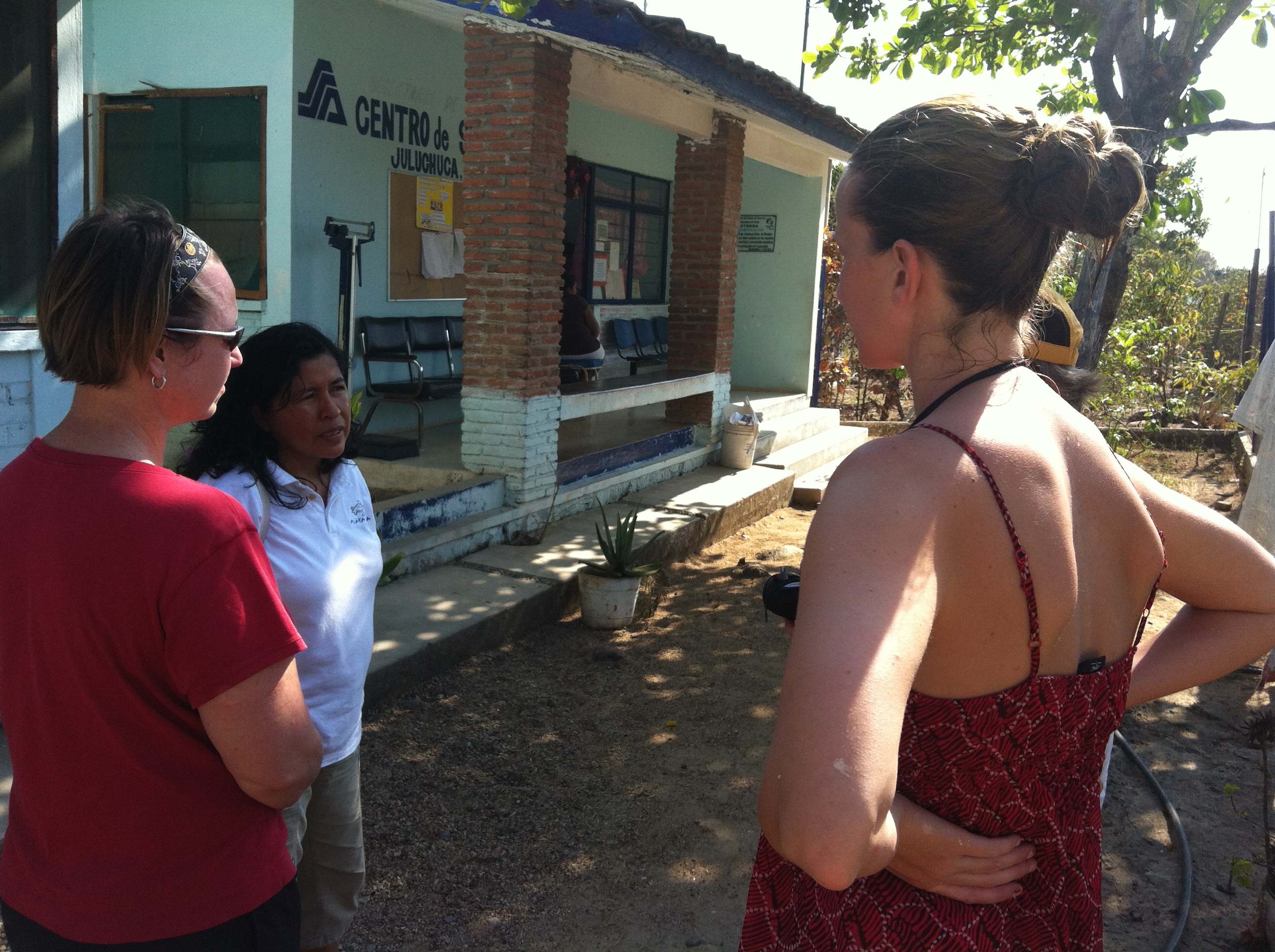 Several days of my first week there the doctor has held classes in health issues with different groups of women, who receive financial support. I have also helped her vaccinating many of these women with the tetanus and diphtheria vaccine. Yesterday the doctor and I were invited to have lunch at one of the patients’ restaurant on the beach. It was a wonderful experience and an amazing possibility to get to know a bit more about the local culture and the people who live here.
Several days of my first week there the doctor has held classes in health issues with different groups of women, who receive financial support. I have also helped her vaccinating many of these women with the tetanus and diphtheria vaccine. Yesterday the doctor and I were invited to have lunch at one of the patients’ restaurant on the beach. It was a wonderful experience and an amazing possibility to get to know a bit more about the local culture and the people who live here.
The clinic and the doctor clearly contributes in an essential way to the local community, both in terms of prevention and treatment, especially for the poorer population, but is definitely in the need of thorough reconstruction economic support.
NOTE from Playa Viva Team – We are working with Malene and Jenny to develop a list of items that are needed, a set of repairs that need to be done and resources necessary to improve the clinic. Stay tuned for more details. The goal, like our school improvement project, is to work with the locals to provide labor while we provide the needed resources to team up with guests and make needed improvements. If you will be at Playa Viva in the Winter and Spring of 2014 and would like to assist in improving the clinic, please let us know. All ideas welcome.
New Pair of Shoes and School Supplies
 Contribution by Evan Silberstein, host at Playa Viva.
Contribution by Evan Silberstein, host at Playa Viva.
On the first day back to school after Holiday break and fresh on the heels of Three Kings Day (Dia de los Reyes), Playa Viva visited three local schools and the library in Juluchuca to deliver the bounty of supplies our guests have brought with them thus far in Season 5.
Pens, pencils, markers, crayons, paints, books, pads , rulers, calculators and lots more, including over thirty pairs of sneakers and shoes, were safely delivered to the local Kindergarden, Elementary and High School right here in Juluchuca. The library also received a great pile of new reading materials and some sorely needed supplies.
Several guests joined Johnny, Evan and Oliver (our newest permaculture and garden volunteer) for a fun day meeting and sharing with the local community. We greatly appreciate each donation that our guests make and work hard to make sure they are shared equitably to those places in our community that are most in need.
 Our next scheduled delivery is later this spring for Niños Day on April 30. We thank you in advance for your generous donations to this community outreach and support program at Playa Viva.
Our next scheduled delivery is later this spring for Niños Day on April 30. We thank you in advance for your generous donations to this community outreach and support program at Playa Viva.
NOTE from Playa Viva: School Supplies are brought by guests as part of our participation in the Pack for a Purpose Program as well as our relationship with Debra Reynolds, who on her own works with local shoes stores in the SF Bay Area to collect shoes as parents turn in slightly used shoes to buy new ones for their growing children. Rather than have those shoes become waste, they are donated to needy kids, in this case, in our community. In many cases, these shoes are as good as new. An internet search found this organization, Soles4Souls, with the same mission. Thank you all for donations, contributions and for carrying entire suitcases of shoes to Playa Viva for distribution.
